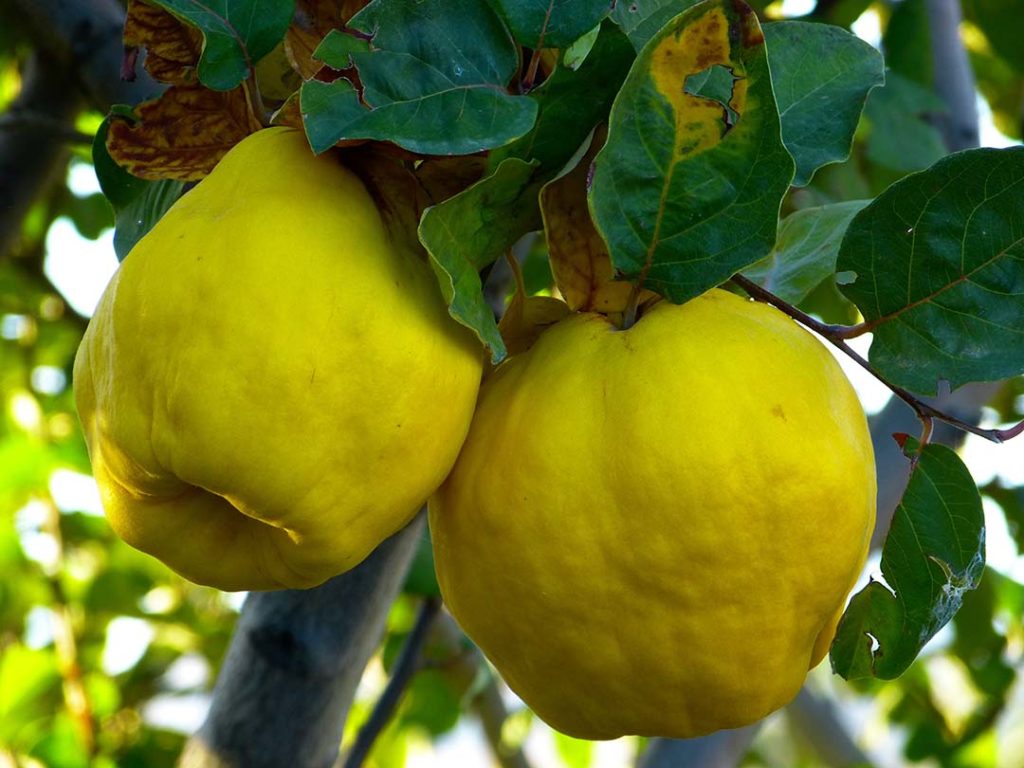
Macedonia
Quince
Cydonia oblonga

General Description / Cultural Significance
Macedonia, now known as the Republic of North Macedonia, is a rocky country formed from ancient metamorphic granite. The country lies at the crossroads of the famed travel routes between the Danube River to the Aegean Sea and the Black Sea to the Adriatic Sea. Every year, Macedonians endure long, hot summers, waiting on the relief of cool, breezy autumns. When the season arrives, with it comes the sweet scent of Macedonia’s most important aromatic plant: Quince, Cydonia oblonga. Native to Macedonia, the plant belongs to the pear and apple family and has been a symbol of fertility, joy, and love since ancient times. Quince bears beautiful flowers in the spring and sprouts its round, amorphous fruit in the fall. It is then that the Quince fruits are picked from the trees which most Macedonian’s cultivate right in their backyards. Quince is reduced into a special preserve called Slatko Od Dunji, made into jams and deserts, stuffed into ground meat, cooked with potatoes, and included in many more culinary traditions.
Macedonians appreciate Quince for more than just its sweet flavor: the plant is very nutritious, high in Vitamin C, B1, B2, and antioxidants, and has anticancer properties. The fruit’s tannins and mucus help prevent disease and aid in digestion while also curing diarrhea, eczema, stomach flu, respiratory inflammation, and more. As winter comes, Macedonians dry their Quince and hang the fruit around their homes as an aesthetic and aromatic reminder of the beautiful season that has come and gone.
Climate Change / Conservation Status
Macedonia is experiencing increased temperatures, more extreme flooding, and droughts. These changing weather events put Macedonia’s agriculture and vegetation at great risk as more than half of the country is blanketed by now vulnerable forest. The Macedonian Pine has already migrated 400 meters higher in altitude over the course of ten years because of increased air temperatures. The country’s Fir and Oak stands are predicted to follow. Many of Macedonia’s pasturelands have been abandoned, no longer viable for cultivation, leaving room for shrubby vegetation to take over which is reducing biodiversity in the grasslands of the country. Industrial water pollution is affecting biodiversity and the stability of all ecosystems while soil contamination encroaches on green urban areas and agricultural communities where Quince is grown locally.
A recent scientific study found that the antioxidant activity of Quince fruit decreased under water stress. Climate change will inevitably lead to more water scarcity, which Cydonia oblonga already faces in Macedonia and throughout the Mediterranean. If drastic changes are not made to irrigation practices and agricultural systems, the plant’s profitability will continue to decline, threatening the Mediterranean economy as well as the cultural and medicinal connection every Macedonian holds dearly to Quince.
Alternate Names
Safarjal (Arabic)
Sources
Climate Links, 2018. North Macedonia. USAID. [website]
Climatechangepost.com, 2022. Forestry and peatlands in North Macedonia. Centre for Climate Adaptation. [website]
Danforth, L., 2022. North Macedonia. Encyclopædia Britannica. [website]
Fox, E., 2007. Quinces! The Garden of Eating. [website]
Griñán, I. et al., 2019. Volatile composition and sensory and quality attributes of quince (cydonia oblonga mill.) fruits as affected by water stress. Scientia Horticulturae, 244, pp.68–74.
GRNM, 2003. Ministry of Environment and Physical Planning. Government of the Republic of North Macedonia. [website]
Kochilas, D., 2018. Quince in the Greek kitchen. Greek Recipes. [website]
Macedonian Cuisine, n.d. Quince Preserve (slatko od dunji). Macedonian Cuisine. [website]
Permanent Mission of the Republic of Macedonia to the United Nations. This statement can be found on the World Sensorium original website.

